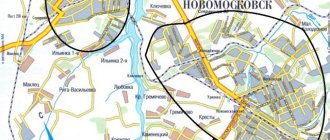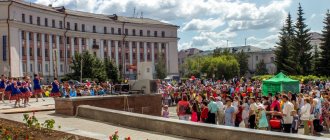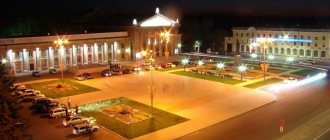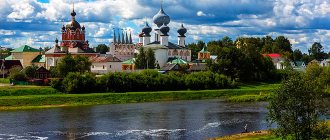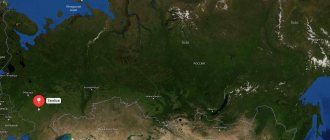Content
- 1 General information
- 2 City leaders in the post-Soviet period 2.1 Seversk leaders after October 2020
- 2.2 Mayor, also the Chairman of the City Duma (until October 2020)
- 2.3 City manager (period from 2005 to 2015)
Education
Secondary professional institutions
- SEC
-
Seversky Industrial College
- has been operating since 1959 to the present.
General information
Seversk is the largest closed city of Rosatom (formerly Minatom of the Russian Federation). Population size:
- as of January 1, 2006 it is 114,100 inhabitants;
- as of January 1, 2009, there were 107,073 inhabitants, and within the new expanded borders of the ZATO (including the villages of Samus and Orlovka, the villages of Kizhirovo, Chernilshchikovo and Semiozerki) there were 113,800 inhabitants.
The total area of ZATO is currently 48,565 hectares (ha).
The city was founded in 1949 as a settlement at the Siberian Chemical Plant, and became a city in 1956. The townspeople called it Tomsk-7
and
the Fifth Postal
, in the world - “
Belaya Beard village, Atomsk
”. Later, a competition was announced in which each resident could propose a name for the city.
(More details
: see History of Seversk)
The ZATO Seversk includes 6 settlements: the city of Seversk itself, the villages of Samus, Orlovka, Chernilshchikovo, the villages of Kizhirovo, Semiozerki.
Seversk has a namesake city in Ukraine, in the Donetsk region (population in 2006 - 13.9 thousand people), and Seversk was also often called Novgorod-Seversky, located in the Chernigov region of Ukraine (population 15.2 thousand people). ).
Seversk telephone code: (+7) 3823, intraregional telephone code - 3, postal codes: 6360xx. Telephone numbers are six digits and begin with 5xxxxxx, 7xxxxxx and 9xxxxxx
Excavations
Once upon a time, interesting instruments were found in this remote area. It is known that the land is not particularly developed in terms of population, but mammoths, tusks and other creatures seem to have walked here before people. As for the specifics, this is not fiction and there is actually information on Wikipedia that the skeletons of these ancient creatures were found in these parts of the village. Among other things, there are fine engravings on the mammoth tusk. Accordingly, some intelligent people used to be involved in culture. It is difficult to say whether this was our country or not, in any case, perhaps the descendants of some of the inhabitants of this zone.
Kyonga is a village in Tomsk region
Kedrovka village - a village in the Tomsk region
Vysoky Yar is a village in Tomsk region
Pervomaisk (Bakcharsky district) - a village in the Tomsk region
Plotnikovo is a village in Tomsk region
Podolsk is a village in the Tomsk region
Chernyshevka is a village in Tomsk region
Vavilovka is a village in Tomsk region
Borodinsk is a village in Tomsk region
303
City leaders in the post-Soviet period
Leaders of Seversk after October 2020
- When changing federal legislation, the rule of law established that from 2022 in Russia, officials cannot simultaneously hold two positions - the head of the territorial legislative body and the position of the chief executive officer (mayor). In this regard, on October 16, 2022, at the session of the Duma of the city of Seversk, elections of two officials took place: the chairman of the City Duma of the closed city of Seversk and the mayor, who, at the same time, according to the Charter of the closed city of Seversk, is the head/head of the Administration of the closed city of Seversk.
Grigory Andreevich Shamin
was again elected Chairman of the Seversk Duma .
Nikolai Vasilyevich Didenko
was elected and confirmed as mayor of Seversk .
Mayor, also known as Chairman of the City Duma (until October 2020)
- from October 21, 2005 to October 21, 2010, the mayor of the city and chairman of the city duma of the first convocation was Nikolai Ivanovich Kuzmenko. In fact, he has been the head of the city since 1984[1] - he held the position of chairman of the Seversky City Executive Committee and one of the leaders of the Seversky City Committee of the CPSU.
- from October 21, 2010 to October 16, 2022, the mayor of the city and chairman of the city duma of the 2nd convocation is Grigory Andreevich Shamin
, previously deputy chairman of the Duma of the Tomsk region[2].
City manager (period from 2005 to 2015)
- from 12/22/2005 to 07/02/2007 - the head of the administration was Sergei Borisovich Tochilin (he left for the post of first deputy governor of the Tomsk region);
- during the period 07/02/2007 - 08/30/2007 - acting. the head, then the head of the administration from 08/30/2007 to 12/01/2008 was Anatoly Petrovich Abramov, a professional manager-economist from Tomsk;
- from 02/19/2009 to 01/31/2013 - the head of the administration was Igor Evgenievich Volkov, an engineer and technical worker at the Siberian Chemical Combine and an activist;
- from 02.02.2013 - acting head, then head of administration from 04/03/2015 Nikolai Vasilyevich Didenko, member, previously worked as the first vice-mayor of Tomsk, then, before being transferred to Seversk, as vice-mayor of Novosibirsk.
From 1991 to October 2005, the position of head of the city administration was held by Nikolai Kuzmenko.
Previously, instead of the City Duma, the legislative body of Seversk was the Assembly of People's Representatives
[3].
Sport
There are famous athletes from the Seversk land, including Olympic champion in skiing Lyubov Egorova.
Here we can also include Margarita Aliychuk, who is involved in professional gymnastics and trained at the Seversk Sports School named after Kuznetsov.
History of Seversk
On the territory of the future ZATO there are archaeological excavations, TSU scientists, and then Seversk local historians and historians are studying the life of the post-Aryan, Scythian and Finno-Ugric, Tungus tribes who lived here in the period earlier than 3000 BC using artifacts [4]. Less than a thousand years ago, tribes of Siberian Tatars also settled in these places. The migration routes of many subsequent peoples lay here during the period of the late Golden Horde ( White (Siberian) Horde
or it is
the Siberian Kingdom
) a mixing of many tribes took place here. After Ermak’s defeat of the capital of Khan Kuchum[5], the processes of disintegration of the union of peoples began in the White Horde and the Siberian Tatars on the Tom and Ob faced the threat of their settlements being destroyed by raids of previously friendly nomadic Kyrgyz. At the invitation of the Siberian Tatars, the Moscow Tsar creates several strategic Cossack forts in Siberia on the banks of the Ob, Irtysh and Tom rivers. At the confluence of the Ushaika River with the Tom (20 kilometers south of modern Seversk), the Tomsk fort appears, which soon began to exercise the main military-political and cultural influence throughout Southern Siberia, contributed to the development of new lands by its Cossacks to the east - along the Yenisei and Angara rivers in Transbaikalia and in the Far East. East.
More than 300 years ago, new waves of resettlement began - Russian Cossacks founded villages in the Tomsk Priobye and Pritomye, while the new settlers were always friendly with the population that already had their own rare settlements here. These are the Ostyaks, Kerzhaks, Tungus, Khanty and Mansi, Tomsk Tatars. Another wave of the influx of the Russian population was the resettlement of peasants from Central Russia to Siberia as part of the Stolypin reform of the early 20th century. The development of the territory in the 19th century was facilitated by two main factors: the rapid development of capitalism in Siberia (based on the development of Tomsk river navigation from Yeniseisk and Tobolsk to Barnaul and Kuznetsk) and mass exiles here of mainly highly educated populist revolutionaries, later - socialist revolutionaries and then rare in 1890-1907, Social Democrats of the RSDLP, - from Little Russia (modern Ukraine), Belarus, Poland, the Baltic states, Moscow and St. Petersburg.
Before the October Revolution of 1917, in the villages on the territory of the modern ZATO, the future hero of the First World War, a cavalry maiden, a full Knight of St. George, the legendary Maria Bochkareva, lived as a child.
Before and after the Revolution, scientists from Tomsk State University discovered sites of ancient settlements on the territory of the future ZATO, and began the first excavations of the discovered Irmen culture
.
On March 26, 1949, the Council of Ministers of the USSR decided to begin the implementation of the domestic Atomic Project
and on the creation of a plant near the city of Tomsk for the production of highly enriched uranium-235 and weapons-grade plutonium.
The new industrial complex was initially called the “ Trans-Ural Office of Glavpromstroy
” or
Plant No. 816
. On July 26, 1953, just four years after the start of construction, the first Siberian uranium was produced at the isotope separation plant, part of the Siberian Chemical Combine. The world's first industrial nuclear power plant (NPP-1, also known as the Siberian Nuclear Power Plant) with a capacity of 100 megawatts, founded by order of USSR Minister L.P. Beria, was built in Seversk in 1958.
On the site of the future city in 1933, the youth labor commune “Chekist” was created for street children collected by the NKVD in Central Russia (later - forced labor colony No. 1 Siblag UITLIK NKVD USSR), which transferred its name to the village in which the city’s first builders lived . This ZATO microdistrict still bears the name “Chekist village”. The city of nuclear scientists developed towards the Tomsk villages of Beloborodovo and Iglakovo. In the developments of foreign intelligence services, the secret facility (city and plant) has long been designated as Belaya Boroda
.
The village of Beloborodovo in the city ceased to exist in the 1980s. The village of Iglakovo still exists today and has acquired the status of a city microdistrict.
The city had several original names, one of the most euphonious was the village of Berezki
.
In 1954, the closed city was given the name Seversk
, but later in documents, for reasons of secrecy, it began to be called
Tomsk-7
.
People simply called the city " Postal"
" - due to the fact that the construction of the plant was called "Mailbox No. 5", or "
Fifth Post Office
".
To build the plant, concentration forced labor camps were organized by order of the USSR Minister of Internal Affairs. Prisoners worked not only at industrial facilities, their labor was also used in the construction of residential buildings and urban infrastructure. About 20 thousand prisoners worked in the construction of the closed city and the plant. In addition to prisoners, thousands and thousands of young people from different parts of the USSR came to Seversk for the construction of the city, for the commissioning of the production facilities of the future Siberian Chemical Combine - scientists, military personnel, engineers and technical specialists, highly qualified workers, etc. In memory of the builders, creators of Seversk and the Siberian Chemical Combine in the city, a memorial monument was erected at the beginning of the main avenue.
The great infrastructural development of the Siberian Chemical Combine, Seversk, systems for using excess hot water for vegetable growing, for heating microdistricts of the regional center - Tomsk, the rapid development of the social and cultural life of the city are associated with the fact that the country’s Atomic Project was given attention by the “atomic minister” E.P. Slavsky and the first secretary of the Tomsk regional committee of the CPSU E.K. Ligachev.
The secrecy of Seversk and the Siberian Chemical Combine left its mark on the entire Tomsk region. During the Soviet era, the entry of citizens was limited here and the entry of foreign citizens was almost completely prohibited. Secrecy from the name “Seversk” and security restrictions from Tomsk and the Tomsk region were lifted after perestroika, in 1990, mainly on the initiative of the Secretary of the CPSU Central Committee E.K. Ligacheva.
In March 1997, according to the Decree of the President of Russia, a closed administrative-territorial entity (ZATO) was formed, which included the city of Seversk, the villages of Samus, Orlovka, Chernilshchikovo, the villages of Kizhirovo, Semiozerki.
The city continues to be in a state of special regime for allowing citizens into it. You can get to Seversk only with a special pass. There are two roads leading into the city, on which the Central and Sosnovsky checkpoints are located. There are checkpoints within the city for citizens to access the Tom River embankment.
Attractions
The city has memorials and monuments, as well as monument buildings. Including the most famous among them:
- 1st Memorial of the city of Seversk in memory of fellow countrymen who went to defend their homeland on the fronts of the Great Patriotic War (residential complex "Yasny", square near the house "Lenin St., 128")
- The main Memorial of the city of Seversk in memory of the fallen Soviet soldiers who defended their Motherland on the fronts of the Great Patriotic War (Solnechny microdistrict, square opposite the house "Lenin St., 92" - ravine of the banks of the Tom River)
- Memorial of the city of Seversk “To the residents of Seversk who conquered the atom” (Kurchatov Square, Kurchatova St., 5 / Kommunistichesky Avenue, 92)
- Memorial of the city of Seversk “To the first builders of the city” (square at the intersection of Komsomolskaya St., 11 / Kommunistichesky Prospekt, 1)
- Memorial of the city of Seversk “In memory of the Seversk residents who died during the liquidation of the accident at the Chernobyl nuclear power plant” (northern square of the city)
- Military Memorial of the city of Seversk “To the soldiers of the Seversk Division of Internal Troops who died in the line of duty,” including the BMP-2 installed here (Kalinina St., 63)
- Military Memorial of the city of Seversk “Immortal Regiment: in memory of fellow countrymen who went to defend their Motherland on the fronts of the Great Patriotic War” (Kalinina St., 63)
- Memorial of Honor “To the Seversk residents who deserved fame and respect and were buried in the city of Seversk” (Severskoye Sosnovskoye Cemetery, Alley of Honor; Sosnovaya, 1)
- The monumental sculpture “Leader of the World Proletariat Vladimir Ilyich Lenin”, the largest in the territory of the ex-USSR. Installed in front of the facade of the Administration of ZATO Seversk on Lenin Square (Kommunistichesky Avenue, 51)
- (Leontichuka Street, 5 / Kommunistichesky Avenue, 22/1)
Literature
- Atomic weapons of Russia: Biographical Encyclopedia A-Z / [comp. M.A. Pervov], Ed. V.B. Akhmadyshev. - : “Capital Encyclopedia”, 2012. - 723, [1] p., [40] l.col.il.: portrait; — ISBN 978-5-903989-15-7 (translated).
- Veselovsky A.Ya.
Nuclear shield.
- Sarov: RFNC-VNIIEF, 1999. - 248 p., ill. — Electronic resource
: elib.biblioatom.ru. - Zinoviev V.P.
History of Seversk. - Tomsk: Tomsk University Publishing House, 1999. - 258 p. - Zinoviev V.P.
Village Chekist // Unknown Seversk. - Tomsk: Tomsk University Publishing House, 1996. - P. 60-79. - Zinoviev V.P.
Intelligentsia of the Chekist village // Education. Culture. Spirituality: materials from the first Seversk cultural and historical readings dedicated to the days of Slavic culture and writing. - Tomsk: Tomsk University Publishing House, 1996. - pp. 68-69. - History of Seversk. Essays. - Seversk: publication of the Museum of the City of Seversk, 2009. - 380 p. History of Seversk. / Ed. V.P. Zinoviev. - Seversk
: publication of the Museum of the City of Seversk, 2009. - 380 p.
Closed administrative-territorial formations “Nuclear” cities [monograph] / D.Yu. Faykov. - Sarov: RFNC-VNIIEF, 2010. - 269, [3] p.: ill., book, table.
Notes
- Mayor Nikolai Kuzmenko will go to the polls... as a voter
- First session of the Duma of the second convocation
- Official website of the Assembly of People's Representatives of ZATO Seversk
- The so-called settlements of the Irmen culture
on the territory of the southern part of the ZATO in the Greater Kyrgyz Hills.
Read more: Vasiliev, Evgeniy Alekseevich
. Real and imaginary secrets of the Greater Kyrgyz “hills”. // magazine "Seversky Meridian", - Seversk, 1999. - No. 3 (May). — P.59-61. - Khan Kuchum violated the agreement between the former leaders of the Siberian Kingdom and the Russian Tsar on reunification and, together with the Crimean Tatar Khan and Turkish forces, began active military operations against the Russians in the second half of the 16th century.
Climate
In winter, sub-zero temperatures are not very different from the European part of Russia, but this time cannot be called warm either. The thermometer probably differs by several degrees and lasts several days longer. You can’t call it severe frost, but it’s ok for the Siberian winter.
Spring and Summer are typical in the Urals and Moscow. Perhaps there are features related to winds and air, but they are not so significant. +20 degrees in June is quite warm.
September and October often have above-zero temperatures. From November it begins to get colder faster than in the European part of the country. In the second half of autumn, you can no longer expect above-zero temperatures, except in rare cases of abnormal weather.
Links
- Website of the administration of ZATO Seversk
- Records of the closed city
- Website of the Club of Young Families "Convergence"
- The brainchild of Joseph Stalin and... river workers
- Map of Seversk on Google (traffic)
- Detailed map of ZATO Seversk on People's Yandex. Map
- A walk around Seversk - the closed city of nuclear technology
- Weather in Seversk - weather forecast for 10 days
- Seversk recording studio "Art Legion"
- New historical facts: “U-2 spy plane over Tomsk in 1957. CIA Operation Birch Woods” (publication date: 09.18.2016, photo)
- News Agency “Tomsk Review” (07/12/2019): The issue of removing the “closed” status from the closed city of Seversk is being considered
- Seversk How does the city live behind barbed wire?
| Administrative division of the Tomsk region | |
| Cities of regional subordination: Kedrovy, Seversk, Strezhevoy, Tomsk | |
| Cities of district subordination: Asino, Kolpashevo | |
| Districts (administrative centers in brackets): | |
|
|
Population
Until 1994, the city's population, albeit slightly, increased. About a thousand new settlers arrived in Seversk. But this year became a turning point, and instability followed. Most likely, this trend is associated with larger-scale reasons. Probably the special status of the city with checks at the entrances saved it from the tense times of the 90s.

